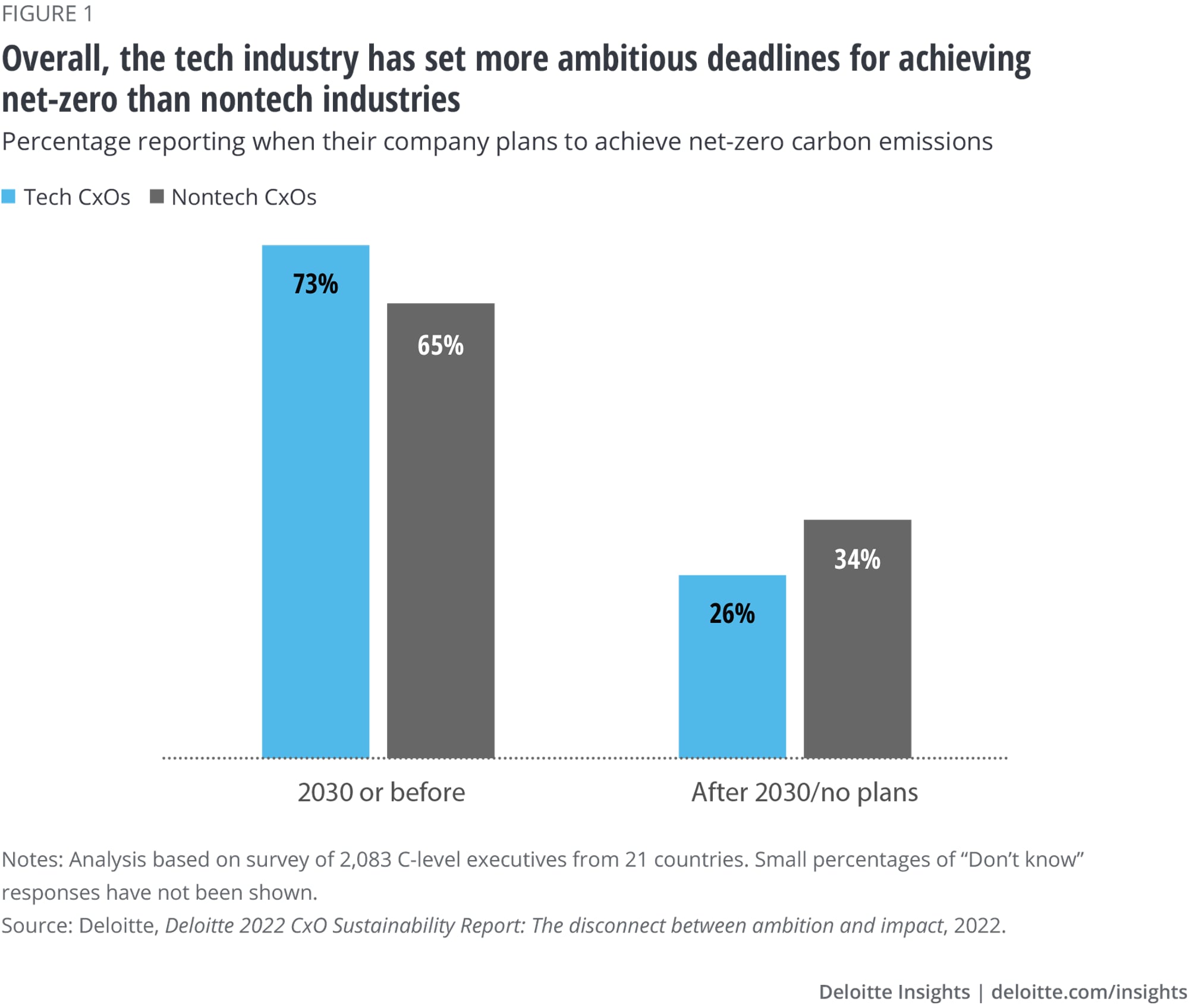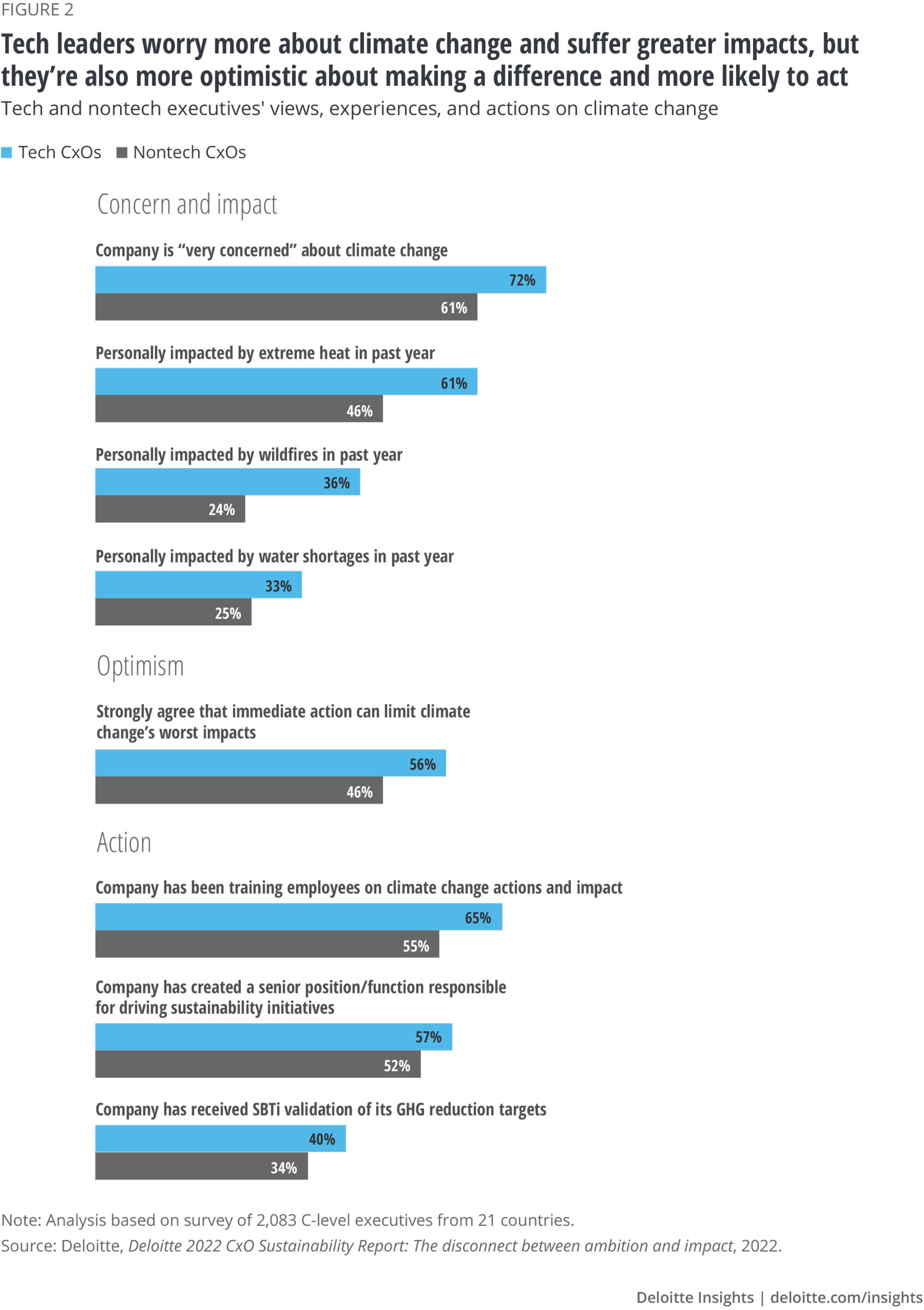Tech’s climate commitment: Organizational and personal impacts are pushing tech leaders toward faster climate action
The technology industry has set ambitious deadlines for achieving net-zero. Operational efficiencies, sustainable products, and tech innovations can help it get there.
Susanne Hupfer
Ariane Bucaille
Karthik Ramachandran
Gillian Crossan
Achieving net-zero1 is a priority for many organizations today, and the technology industry is taking the imperative to heart. Deloitte Global predicts that in 2023, the tech industry will move faster on climate action than nontech industries. By “move faster,” we mean that more tech companies say they’re aiming for net-zero by 2030 than nontech companies. Deloitte’s 2022 CxO sustainability survey, which polled more than 2,000 C-suite executives worldwide, found that technology executives viewed net-zero as a more urgent priority: They were 13% more likely to target net-zero by 2030, and 24% less likely to push that goal past 2030 or have no plans (figure 1).2

Tech executives feel increasingly concerned and impacted. They’re also more likely to act.
That tech leaders are in a hurry to mitigate climate change may not be surprising, considering the attitudes and experiences they reported in Deloitte’s survey. Tech executive respondents were more likely to be worried about climate change than those in other industries, and more likely to report personal impacts (figure 2).3 Their direct experience with climate-driven adversity may be one reason they intend to act quickly.
Organizational impacts from climate change are growing—and quickly. Thirty-seven percent of surveyed tech executives reported that their organization is already experiencing a scarcity of resources such as water and energy—up eight points from a similar Deloitte survey conducted only eight months earlier. Thirty-eight percent said that they were feeling the cost of climate change mitigation—more than double the prior survey’s percent. And 42% percent said that their operations had been affected by climate-related disasters or weather events—up 18 points from the earlier survey.
These organizational disturbances are often consequential. For example, during London’s record-breaking July 2022 heat wave, two global tech companies’ cloud-based data centers experienced service disruptions due to cooling failures.4 In August, facing historic heat and drought that jeopardized the region’s power supply, China’s Sichuan province shut down factories, including electronics component makers that supply major tech companies.5 In 2019, US scientists were forced to power down one of the world’s most powerful supercomputers twice in two weeks due to preemptive multi-day power cuts intended to mitigate wildfire risk in northern California.6 And in 2021, severe winter storms in Texas triggered days of power outages and closed three major semiconductor plants.7
Stakeholder pressure is lending additional weight to these organizational and personal incentives. These include investors as well as customers, board members, and especially US and EU regulators that mandate more rigorous disclosures on greenhouse gas (GHG) emissions, environmental risks, and mitigation actions.8
Despite confronting these challenges and pressures, tech leaders aren’t throwing their hands up in despair. On the contrary: The 2022 Deloitte survey found that tech executives were more likely than executives in other industries to believe that immediate action could mitigate climate change’s worst impacts. Nine in ten of the surveyed tech leaders believed that their companies’ current sustainability initiatives will help mitigate climate change. And eight in ten believed their efforts would boost investor and customer satisfaction, employee morale, brand recognition, operating margins, revenue from new businesses, supply chain resilience, and innovation.9
What’s more, tech companies were more likely than nontech companies to have taken several steps toward mitigating climate change: creating a senior position to drive sustainability efforts, training employees on climate change actions, and publicly committing to a GHG reduction target through the Science-Based Targets Initiative (SBTi)—a coalition that helps companies set goals and timelines for reducing emissions (figure 2).10 As of August 2022, 338 of the 3,545 companies that have committed to developing net-zero targets with the SBTi were from the technology sector, making it the second-largest industry segment represented.11 More than four in ten of these tech signatories have already set emissions reduction targets.

Other signals also point to the tech industry’s sustainability leadership. For instance, a 2021 analysis found that of the top 10 US companies by market value, the five with the earliest deadlines for reaching net-zero were all tech giants.12 The tech industry is already among the biggest global buyers of renewable energy: In 2021, tech giants were responsible for more than half the corporate purchase agreements for clean energy.13 On the regulatory front, too, some large tech companies have themselves been advocating for mandatory disclosures on climate change.14
Such leadership is welcome from an industry estimated to be responsible for 2–3% of the world’s GHG emissions, mainly due to the enormous energy demands of technology manufacturing processes, billions of connected devices, and proliferating data centers.15 The good news is that the tech industry is starting from a smaller carbon footprint than others, and it has many opportunities to both reduce that footprint and help others do so.16 We’re seeing tech companies lead in several broad ways such as:
- Tackling carbon reduction more aggressively—and influencing ecosystems. Tech giants are investing heavily in global solar and wind farm projects to power their operations.17 Addressing the broader value chain, Apple is helping its suppliers shift to renewable energy and also investing in a new solar farm to account for the energy consumed by its product users.18 Aiming for half its shipments to be carbon-neutral by 2030, Amazon has launched package deliveries that use e-cargo bikes, people on foot, and electronic vehicles.19 And Google intends to run on carbon-free energy 24/7 by 2030, which involves innovations like geothermal power and smartly routing computing tasks to locations with carbon-free electricity.20 Some tech leaders are also influencing broader ecosystems to commit to net-zero: The Climate Pledge, for instance, was co-founded by Amazon in 2019 and now has nearly 400 signatories, including several other large tech companies.21
- Making their products more climate friendly. Some tech companies are tackling the e-waste problem by using more recycled materials in products, designing them for better repair and recycling, and promoting a circular economy for electronics.22 Having recovered two billion pounds of discarded electronics and used 100 million pounds of recycled material in new products by 2020, Dell now aims to have most of its product content made from renewable or recycled material by 2030.23 And Apple is purchasing the first commercial, low-carbon aluminum for use in its phones.24
- Creating climate tech that tracks and mitigates the effects of climate change—for themselves and their customers.25 For example, several tech companies have debuted tools that help customers track emissions from their cloud and software use.26 Others are investing in carbon capture technologies.27 Still others are using analytics and robotics to decrease energy consumption: For instance, Google has been using DeepMind AI software to trim its data centers’ power usage and to predict power output from wind farms.28 And companies can use tech advances such as environmental monitoring satellites, IoT, data analysis, blockchain, and AI to increase efficiencies in buildings, manufacturing, and agriculture; improve data center management; and reduce traffic congestion.29
The bottom line
To meet the challenge of climate change, tech leaders can consider how their company’s mission, operations, business models, and products and services may need to adapt:
- Commit to net-zero. A critical first step is to be clear about the company’s plan and timeline for getting to net-zero. Leaders should consider having their company’s reduction targets validated by an external organization.
- Improve management and governance. Tech companies may need to update their management and governance, such as creating a senior position to drive climate initiatives and linking executive compensation to sustainability performance. Improving governance and data management processes and controls can help ensure thorough and accurate disclosures.
- Adapt operations. Organizations may need to rethink both operations and production. They may need to make buildings, equipment, and manufacturing more energy-efficient, use more sustainable materials, reduce travel, train employees on new practices, and purchase renewable energy.
- Reconsider the product portfolio. Companies can choose to double down on products and services with the most potential to reduce carbon. For example, Vodafone aims to help its customers reduce carbon emissions by 350 million tons by 2030, mainly by supplying IoT services for fleet management, logistics, manufacturing, and metering.30 Through digital innovation, tech companies can help accelerate the decarbonization of other industries.31
- Address the value chain. In the tech sector, value chain emissions are estimated to be 7 times greater than operational emissions.32 Rather than focusing narrowly on their operations, organizations can work collaboratively with suppliers and partners to meet sustainability criteria.33 Ultimately it may be productive to take a comprehensive systems approach, recognizing that today’s industries will likely transform into complex, interconnected net-zero systems.34
Like any industry, tech is vulnerable to climate change risks. But technology executives, more than most, seem to appreciate how vulnerable they are, and many are making strong commitments to do something about it. In 2023, the race to net-zero may see tech companies well represented in the vanguard.